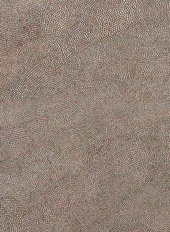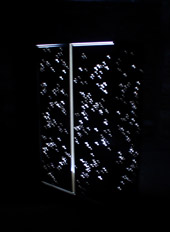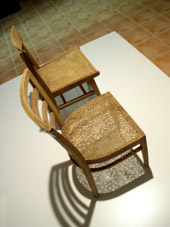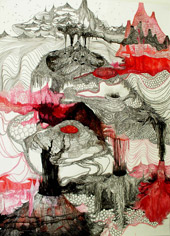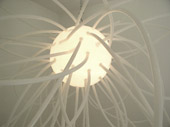SPARKLING REALITY AND PERFORATED ILLUSION
Catherine Bolduc, Rolf Engelen, Luis Terán
1. July – 22. July, 2008
In the practice of her art, Catherine Bolduc tries to stage the way we perceive and build the “real” by casting our desires into it, by transgressing reality by means of the fabrication of the marvellous. In her work, the oscillation between the pleasure of the aesthetic illusion and its unavoidable breakdown is akin to the experiences of illusions and disillusions strewn through our lives. Her work recalls the vulnerability of humankind, faced with the inevitable discrepancy between our desires and reality.
The artistic practice of Catherine Bolduc takes shape in large dimension installations and drawings.
Her installations are often ephemeral, and, more often than not, achieved in situ. The intent of her installations is to invite the onlooker to experience a phantasmagorical setting, self-tinkered, obviously contrived, highly recreational, where the commonplace leads to amazement. In her installations, deliberately chosen flashy effects of mirrors, coloured lights, stroboscopes and other eye-catching devices magnify a bewildering array of bric-a-brac arrangements; however the precariousness of the structure, or else the unbearable play of the lighting reduce the awesome sight into oblivion, like a house of cards.
In her drawings, she play with images of fantasy by evoking romantic painting, fairy tales or science–fiction. These unreal spaces render an idealized vision of the world, where desire and fabulous inventions triumph over reality and verisimilitude. She realize her drawings by accumulating and juxtaposing motifs in order to create artificial landscapes or fantastic cities where steep mountains, flying carpets, starry skies, volcanoes, castles or exotic palaces for instance, become recurrent figures.
The eclecticism of Rolf Engelen’s work makes it impossible to encapsulate in a single word. He works in the public space, in project-based contexts as well as on commission, and he is involved in several collaborative ventures that operate in the fields of social sculpture and language. He was the co-founder of Museum Van Nagsael, the smallest museum in the world, and the initiator of the weedekansplant-bedrijf ( Second-Chance Plant Company), which has been saving and reviving plants thrown out with the household garbage since 1997. Engelen often involves the public in his working process, such as the residents of a neighbourhood for which he is creating a sculpture. The principle of gift-giving plays an important part in this. Engelen also produces autonomous work, namely objects and drawings.
Transforming the valueless into something valuable is one of the key themes in his work. Engelen usually starts from found materials when creating his objects. The drawings, made in pencil on modestly sized whiter-than-white sheets of paper, emanate from an intuitive process: minimal interventions are used to accentuate a phenomenon that has manifested itself during the repetition of an operation. The automatism of the act of drawing means that the material to which Engelen responds could as validly be termed happened upon as the found materials that are the starting point for his objects. The potential for transformation lies contained in the material, and laying this bare is all that is required. His work is poised between figuration and abstraction: sometimes they are formal, at other times emotional. For example, a 2008 work that started out as a formal study composed of countless little circles evolved into a bestial form and eventually resulted in the Zieke tekening (Sick Drawing), a drawing that actually regurgitates itself.
In the hands of Luis Terán the objects are subject to a subtle change that substantially modify their basic suitability. Everyday things such as a tin of beer or soda may become phantasmagoric light objects. Terán patiently and with great care drills holes around the brand logo, thus obtaining a combination of punctured lines, wich act as filters to the light emanating from a hidden source inside. The core of this type of work is repeated in small marketing brands designed by the artist after the fashion of the packaging used in oriental products. The outcome is a sort of undecipherable advertising technique based on obsessive and repeated manual work. Terán applies the same principle of repetition and puncturing to this drawings and paintings, in the manner of a pervading mantra (orison), wich is endlessly repeated in order to gain another sate of consciousness.
This exhibition presents his works, which are centered around the meticulous and devoted repetition of a simple action by which he perforates everyday objects as well as his own paintings. By the process of perforation he converted common street signs and product packages into light boxes. In the last year he started to perforate three dimensional objects, which this way became light and semi-transparent covered with the marks of the artist's intervention. He also continued a series of paintings that repeats the same decorative composition and colors with small divergences caused by the process of re-production.

